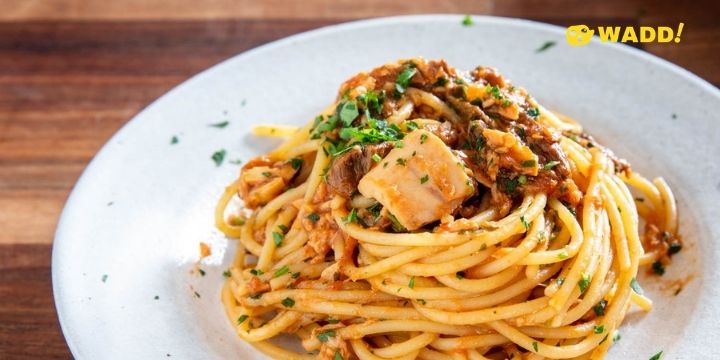Being Malaysian, we are spoilt with choices with it comes to food. We have an option to go for rice or noodles. But there are simply too many noodles choices out there, and sometimes we just want to eat a little healthier.
So let us break it down for you. You make the decision later.
Ranking from the lowest calories to the highest without any seasoning. 1 serving = 1 cup

Japchae is usually made with various veggies, a protein (beef, pork, or chicken), and sweet potato noodles tossed in a sweet, savoury sauce. Image source via omnivorescookbook.com
#1: Sweet Potato Noodles (1 serving = 90 calories)
This sweet potato noodle is commonly used in Korean cooking, especially Japchae. It has a chewy texture. Simple mix in with all your favourite vegetables and protein.
Pros:
- It is made from sweet potato starch and has zero fat.
Cons:
- It has low fibre content, so you have to add more vegetable to make it into a balanced meal.

Stir fry mushroom with Soba Noodle. Image source via nyssaskitchen.com
#2: Soba Noodles (1 serving = 113 calories)
Soba noodles are made from mainly buckwheat flour. Depending on the brand you choose, the higher the percentage of buckwheat flour, the better quality of the soba noodles are. Some soba noodles mix in some wheat flour to make it more affordable, so be sure to read the label.
Pros:
- It is a good source of manganese (0.4mg/cup), 21% of the daily recommended value. Manganese is important for bone health and glucose metabolism.
- Soba noodles contain rutin, an antioxidant that helps to fight free radicals in your body.
- It also contains a lot of other essential protein and minerals like Vitamin B1, magnesium, etc.
Cons:
- Commercial soba may not have as much nutritional value as the traditional ones.

Singapore noodle, the stir-fried curried rice noodles with shrimp, pork, and vegetables. Image source via seriouseats.com
#3: Rice Noodles (1 serving = 192 calories)
Rice noodles are the most commonly use noodles in your laksa and stir fry. It can be the shape of mee hoon, kueh tiaw or kueh chap. Rice noodles are made from white rice flour, water and other ingredients.
Pros:
- It does not contain any wheat flour, so it is suitable for anyone with gluten-intolerant or celiac disease.
Cons:
- It has a higher glycemic index than others, so if you have diabetes, avoid rice noodles.

Udon noodle soup. Image source via eatlittlebird.com
#4: Udon (1 serving = 190 calories)
Udon is made from wheat flour, water and salt. Typically, udon can be found in your Japanese restaurant toss with some Japanese curry or just plain with dashi. Nowadays, you also find fried udon in your typical Kopitiam. The commercial udon may not be beneficial, but homemade udon made with whole wheat flour may provide more fibre in your diet.
Cons:
- The commercial udon does not have much vitamins or other minerals in them.
- For those with higher blood pressure need to pay attention to the sodium amount in udon.

Glass noodles cooked with shrimp and soy-based broth. Image source via bangkokpost.com
#5: Glass Noodles or Vermicelli (1 serving = 200 calories)
Glass noodles or vermicelli is commonly used in a stir fry or your tofu soup. Glass noodles are made from mung beans, flour and water.
Pros:
- It is also suitable for anyone with gluten-intolerant.
- Good source of complex carbs, iron and selenium
Cons:
- It tends to be a bit on the bland side, so the "seasoning" part of the noodles are not so heavy as you probably need more salt, oil, etc., to pump up the flavour.

Roman-style Spaghetti Alla Carrettiera. Image source via seriouseats.com
#6: Traditional Pasta (1 serving = 212 calories)
If you are getting refined wheat flour pasta, you are not getting the nutrients needed.
Cons:
- With the sea-salt like water used to cook the pasta, the sodium is quite high for one cup of pasta.

Mee Mamak Goreng. Image source via food52.com
#7: Yellow or Egg Noodles (1 serving = 221 calories)
Mee Goreng Mamak, ramen and many more dishes use yellow noodles. They are also known as alkaline noodles because it’s made with lye water which acts as a tenderizer for the noodles and gives it its slightly bitter taste.
Cons:
- Some manufacturers replace the eggs in the noodles with yellow colouring to save cost and some yellow noodles have been found to have a high level of boric acid.
Calorie Counter source: Calorie King








